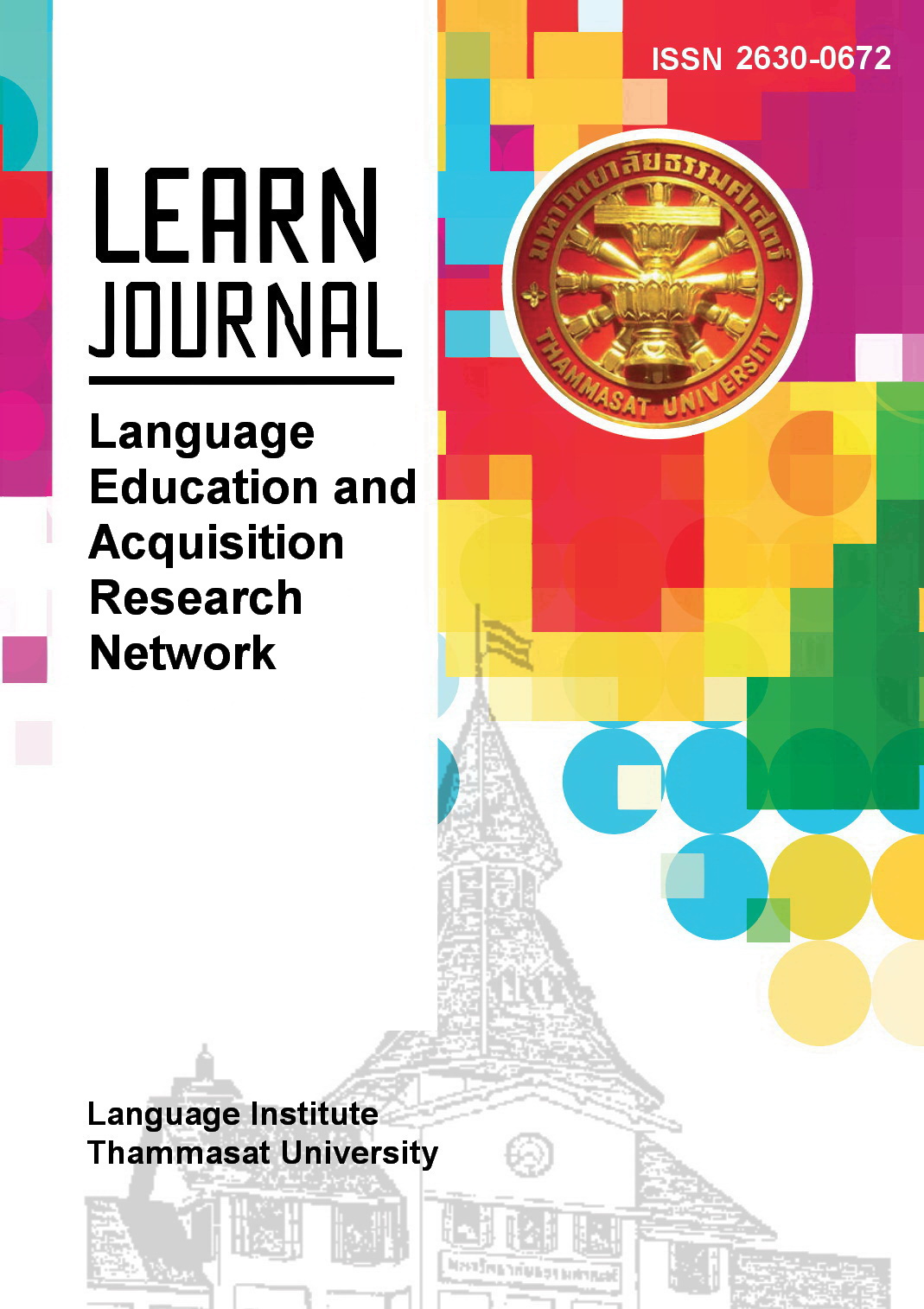Collaborative Strategic Reading (CSR) Instruction and its Effects on Thai EAP University Learners’ Reading Comprehension across Two Proficiency Levels
Main Article Content
Abstract
This study examined the effects of Collaborative Strategic Reading (CSR) instruction on the reading comprehension of Thai university students majoring in Electrical Power Engineering. The participants were 15 more proficient and 15 less proficient learners studying in an English for Academic Purposes (EAP) course. The scores from the pre-and post-reading comprehension tests were compared after 10 weeks of CSR instruction. The results from the Paired-sample t-test indicated that both proficiency groups significantly improved their reading comprehension. With regard to the six reading skills investigated, the results showed significant improvement in the main idea, referential relationship, vocabulary in context, and inference skills, but not in the factual information and organization and logic skills. To explore the participants’ perceptions towards the intervention, an attitude questionnaire and a semi-structured interview were used to collect data. The responses revealed positive perceptions towards the use of CSR instruction. Therefore, it can be concluded that the combination of strategy instruction and cooperative learning in CSR helps improve EAP learners’ reading comprehension and enhance their active involvement in cooperative learning groups. It is suggested that EAP teachers use this viable multi-component instruction to help improve learners’ reading comprehension and active class participation.
Article Details
References
Anderson, N. J. (1991). Individual differences in strategy use in second language reading and testing. Modern Language Journal, 75(4), 460-472. https://doi.org/10.1111/j.1540-4781.1991.tb05384.x
Anderson, N.J. (2008). The practical English language teaching: Reading. The McGraw-Hill Companies.
Anggeraini, Y., Novarita, N., & Afifah, N. (2018). Collaborative Strategic Reading in EFL reading classroom. ETERNAL (English Teaching Journal), 9(2), 34-47. https://doi.org/10.26877/eternal.v9i2.2976
Aulia, S., Mustofa, M., & Karimullah, Imam W. (2020). Collaborative Strategic Reading to improve students’ reading comprehension. Journal Penelitian, Pendidikan dan Pembelajaran, 15(26). 1-13. https://garuda.kemdikbud.go.id/journal/view/26419?issue=Vol%2015,%0No%2026%20(2020):%20Jurnal%20Penelitian,%20Pendidikan%2dan%20Pembelajaran#
Babapour, M., Ahangari, S., & Ahour, T. (2019). The effect of shadow reading and collaborative strategic reading on EFL learners’ reading comprehension across two proficiency levels. Innovation in Language Learning and Teaching, 13(4), 318-330. https://doi.org/
1080/175012 29.2018.1465059
Bouchard, M. (2005). Comprehension strategies for English language learners. Scholastic Inc.
Carrell, P. L. (1984). Schema theory and ESL reading: Classroom implications and applications. The Modern Language Journal, 68(4), 332-343. https://doi.org/10.1111/j.1540-4781.1984.tb02509.x
Carrell, P. L. (1991). Second language reading: Reading ability or language proficiency? Applied Linguistics, 12(2), 159-179. https://doi.org/10.109 3/applin/12.2.159
Chatviriyawong, R. (2017). Development of reading instructional model through Task-based Approach integrating with Collaborative Strategic Reading (CSR) and SCAMPER techniques to enhance creative thinking of vocational diploma students. [Doctoral dissertation, Silpakorn University]. https://so05.tci-thaijo.org/index.php/pacific/article/view/177406/126368
Duke, N. & Pearson, P. D. (2002). Effective practices for developing reading comprehension. In A. Farstrup & J. Samuels (Eds.), What research has to say about reading instruction (3rd ed., pp. 205-242). International Reading Association.
Eskey, D. (1986). Theoretical foundations. In F. Dubin, D. Eskey & W. Grabe (Eds.). Teaching second language reading for academic purposes. (pp. 3-23). Addison-Wesley.
Flavell, J. H. (1979). Metacognition and cognitive monitoring: A new area of cognitive-developmental inquiry. American Psychologist, 34(10), 906-911. https://doi.org/10.1037//0003-066x.34.10.906
Grabe, W., & Stoller, F. L. (2013). Teaching and researching reading. Routledge.
Hyland, K. (2006). English for academic purposes: An advanced resource book. Routledge.
Johnson, D. W., & Johnson, R. T. (1999). Making cooperative learning work. Theory into Practice, 38(2), 67-73. https://doi.org/ 10.1080/ 00405849909543834
Klingner, J. K., & Vaughn, S. (1998). Using collaborative strategic reading. TEACHING Exceptional Children, 30(6), 32-37. https://doi.org/ 10.1177/004005999803000607
Klingner, J. K., & Vaughn, S. (1999). Promoting reading comprehension, content learning, and English acquisition through Collaborative Strategic Reading (CSR). The Reading Teacher, 52(7), 738-747. https://www.jstor.org/stable/20204676
Khonamri, F., & Karimabadi, M. (2015). Collaborative Strategic Reading and critical reading ability of intermediate Iranian learners. Theory and Practice in Language Studies, 5(7), 1375-1382. https://doi.org/10.17507/tpls.0507.09
Maming, K. (2019). Activating EFL learners by integrating team-based learning with Collaborative Strategic Reading. Litera, 18(2), 297-311. https://doi.org/10.21831/ltr.v18i2.23815
Nosratinia, M., & Fateh, N. H. (2017). The comparative effect of collaborative strategic reading and content-based instruction on EFL learners reading comprehension. International Journal of Applied Linguistics and English Literature, 6(6), 165-173. https://doi.org/10.
/aiac.ijalel.v. 6n.6p.165
Nuttall, C. (1996). Teaching reading skills in a foreign language. Macmillan Education.
Oranpattanachai, P. (2023). Relationship between the reading strategy, reading self- efficacy, and reading comprehension of Thai EFL students. LEARN Journal: Language Education and Acquisition Research Network, 16(1), 194-220. https://so04.tci thaijo.org/index.php/ LEARN/article/view/263439
Pongsatornpipat, W. (2021). Interactive group in extensive reading to enhance reading ability of Thai undergraduate students. LEARN Journal: Language Education and Acquisition Research Network, 14(2), 342-371. https://so04.tcithaijo.org/index.php/LEARN/article/
view/253272
Rojabi, A. R. (2018). Collaborative Strategic Reading (CSR) in improving the English department students’ reading comprehension achievement. JET ADI BUANA, 3(2), 127-139. https://doi.org/10.36456/jet. v3.n2. 2018.1723
Saraiwang, S. (2020). The development of an English reading instructional model through problem-based learning integrated with Collaborative Strategic Reading to enhance reading comprehension ability and reading strategy use for undergraduates. [Doctoral dissertation, Silpakorn University]. http://ithesisir.su.ac.th/dspace/bitstream/123456789/3236/1/58254906.pdf
Snow, C. E. (2002). Reading for understanding: toward an R & D program in reading comprehension. Rand Corporation.
Sroinam, R. (2017). The development of English reading comprehension ability using Collaborative Strategic Reading. Udon Thani Rajabhat University, Journal of Humanities and Social Sciences, 6(2), 47-62.
Syafii, M. L. (2022) Enhancing reading comprehension through Collaborative Strategic Reading. ELT Worldwide: Journal of English Language Teaching, 9(1), 135-147. https://doi.org/article/8c2b8c9b0 7b94ccd 999d4d63f 5349295
Vygotsky, L. S. (1978). Mind and society: The development of higher psychological processes. Harvard University Press.
Winograd, P., & Hare, V. C. (1988). Direct instruction of reading comprehension strategies: The nature of teacher explanation. In C. E. Weinstein, E. T. Goetz, & P. A. Alexander (Eds.), Learning and study strategies: Issues in assessment instruction and evaluation (pp. 121-139). Academic Press.


